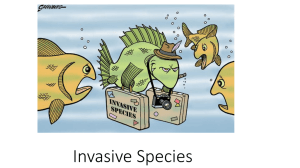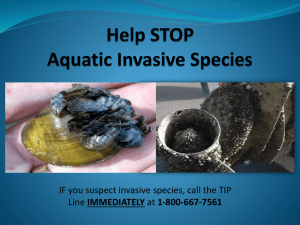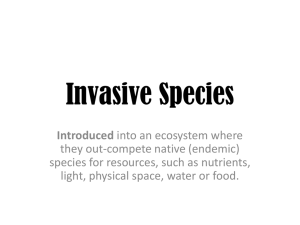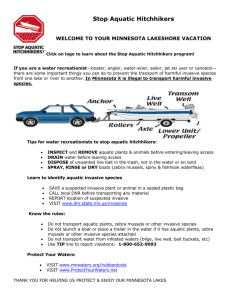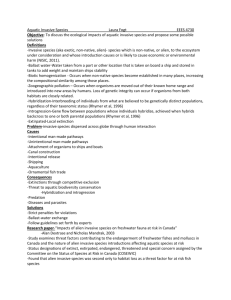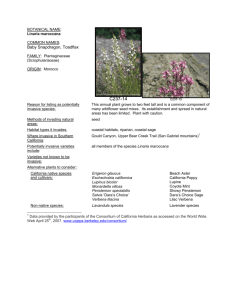11.6-Invasive-Species
advertisement
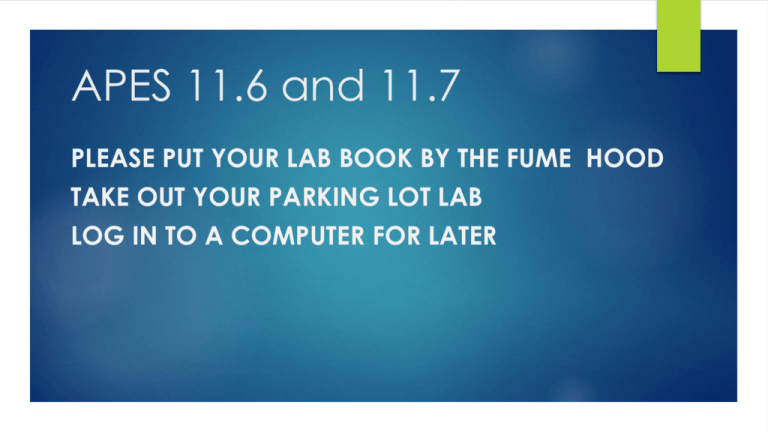
APES 11.6 and 11.7 PLEASE PUT YOUR LAB BOOK BY THE FUME HOOD TAKE OUT YOUR PARKING LOT LAB LOG IN TO A COMPUTER FOR LATER Learning Targets Parking Lot Biodiversity Be prepared to share: Which parking lot was more diverse? How do you know? How could the Simpson Index be used in a real ecosystem? Unit 4 Test Results Multiple Choice out of 42 Short Answer out of 20 A = 38-42 A = 18-20 B = 34-37.5 B = 16-17.5 C = 29.5- 33.5 C = 14-16 D = 25.5-29 D = 12-13.5 Period 2 Class Average = 76% (31.9) Period 2 Class Average = 73.7% (14.75) Retakes for scores below 29 Retakes for scores below 14 Retakes must be done by next Friday, 11/13 Test Corrections 1. Tell me why your multiple choice answer was wrong. Good: my answer, that land at the equator has the highest albedo, is wrong because snow has the greatest albedo SINCE IT REFLECTS SO MUCH LIGHT. Bad: my answer, B, is wrong because I just forgot to study that. 2. Re-answer short answer. EcoColumns Data Collection pH, temperature with probes Nitrate, phosphate with blue test kits D.O. with glass ampule kit Water it with treated water and bubble air in for fish (if you want) Record what you added/subtracted Next week: what do all these #s mean? We will get some background info. and start to make sense of what’s going on. Invasive Species Remember, Invasive Species are one of the 6 threats to biodiversity: Habitat Destruction/Fragmentation Invasive Species Population Growth Pollution Climate Change Overexploitation Native vs. Alien Native Species = species that live in their historical range; thrived there due to natural selection Endemic species = only live in a small area; at greatest risk (i.e. hot springs fish) Alien Species = species living outside it’s historical range Invasive Species= alien species that spreads rapidly across large areas Example: Zebra Mussels Native to Black Sea and Caspian Sea (Europe, W. Asia) Cargo ships carrying seawater came over to St. Lawrence River and the Great Lakes in the 1980’s and dumped their unneeded water Zebra mussels colonized the Great Lakes, killing off native mussels Can multiply so fast (1 female = 30,000 eggs) that they clog industrial pipes! Invasive Species http://wdfw.wa.gov/ais/d / Your Turn! Number off by 4’s 1’s: Silver carp, Kudzu 2’s: Scotchbroom, Cane toads 3’s Brown tree snake, Lionfish 4’s: Nile perch, Asian longhorn beetle For your species: 1. Where they’re from 2. Current range 3. How they spread 4. Why they are so effective at colonizing new areas 5. Negative consequences to native ecosystems Due Next Time Your notes on modules 15, 16, 18, 20 End of module Multiple Choice Key terms not already included in notes Invasive species are NOT homework


